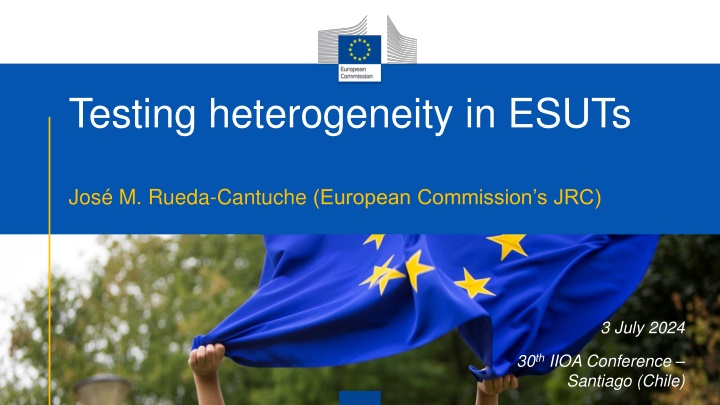
Testing Heterogeneity in ESUTs and Econometric Analysis
Explore the econometric analysis of testing heterogeneity in ESUTs before compiling them, focusing on input-output multipliers and the estimation procedure for employment and output multipliers. Discover how firms' data can be linked to multipliers efficiently without compiling IOTs.
Download Presentation

Please find below an Image/Link to download the presentation.
The content on the website is provided AS IS for your information and personal use only. It may not be sold, licensed, or shared on other websites without obtaining consent from the author. If you encounter any issues during the download, it is possible that the publisher has removed the file from their server.
You are allowed to download the files provided on this website for personal or commercial use, subject to the condition that they are used lawfully. All files are the property of their respective owners.
The content on the website is provided AS IS for your information and personal use only. It may not be sold, licensed, or shared on other websites without obtaining consent from the author.
E N D
Presentation Transcript
Testing heterogeneity in ESUTs Jos M. Rueda-Cantuche (European Commission s JRC) 3 July 2024 30thIIOA Conference Santiago (Chile)
Testing heterogeneity before compiling ESUTs (with econometric analysis) For every product, firms surveyed data can be used to test whether MNEs, for instance, use a statistically significant different technology structure (than the average of the industry) to produce it. This will help countries to identify those industries that would need an additional breakdown by size, ownership, etc. Therefore, there is no need to break down all industries and/or products to construct a ESUT.
Background and context (of the econometric analysis) Firms data can be theoretically linked directly to multipliers without the need to compile IOTs (ten Raa and Rueda-Cantuche, 2007). This approach was extended to SUTs in the absence of firms data (Rueda-Cantuche, 2011). This framework is appropriate for rectangular SUT-type of firms data with more firms/industries (broken down by size, ownership, etc.) than products, as possibly the case for ESUTs. Therefore, by using firms data and the appropriate regressions, input-output multipliers can be derived econometrically, also testing whether those multipliers are significantly different across firms in terms of size, ownership, exporter status, etc. vs. the product technology assumption.
Stochastic analysis of input-output multipliers based on SUTs (ten Raa and Rueda-Cantuche, 2007) Methods for constructing the A-matrix from U and V Stochastic Input-Output Analysis: From A to (I-A)-1 Bodies of literature ( U,V ) A A (I A)-1 (I-A)-1 A U & V
Employment and output input-output multipliers = l (I- A)-1 EMPLOYMENT MULTIPLIERS where l and are the row vectors of labour coefficients and employment multipliers, respectively. A is the technical coefficients matrix and I the identity matrix. = eT(I- A)-1 OUTPUT MULTIPLIERS where eTand are the row vectors of unities and output multipliers, respectively. A is the technical coefficients matrix and I the identity matrix. Bearing in mind that the product technology assumption implies that A = UV-Tand l = LV-T, that is: = LV-T(I- UV -T)-1 = eT(I- UV -T)-1
Estimation procedure (I) For employment multipliers, = LV-T(I- UV -T)-1 = L ((I- UV -T) V T)-1 = L (V T- UV -TV T)-1 = L (V T- U)-1 L = (V T- U) = eT(I- UV -T)-1 = And, therefore, the model would be: For output multipliers, eTV T((I- UV -T) V T)-1 = eTVT(V T- U)-1 eTV T= (V T- U) And, therefore, the model would be:
Estimation procedure (II) Then, by using as independent variables the rows of the net output matrix for each establishment (VT-U), the following multiple linear econometric models can be formulated: Li= 1x1i+ 2x2i + 3x3i+...+ kxki+ i i =1,...,m (for employment multipliers) (eTVT)i= 1x1i+ 2x2i + 3x3i+...+ kxki+ i =1,...,m (for output multipliers) i where multipliers, k the number of products, m the number of surveyed establishments and ian independently normally random disturbance error with zero mean and constant variance. the respective regression coefficients are input-output
Twofold uses of this analysis: Estimation of consistent and unbiased IO (backward) multipliers (incl. employment, output, value added and/or emissions), with confidence intervals. Furthermore, Rueda-Cantuche (2011) showed that the same applied using SUTs instead of firms data (possibly more accessible for academia). Test econometrically whether those multipliers are significantly different across firms/industries vs. the product technology assumption (all firms/industries produce the same product with the same technology).
What do firms data tell about heterogeneity? Li= 1x1i+ 2x2i + 3x3i+...+ kxki+ + 1x1iz1i+ 2x2i z2i+ 3x3iz3i+...+ kxkizki+ i i =1,...,m (for employment multipliers) For product 1 and MNEs ?0:?1= 0 ?0:??= 0 ? ???1?= 1 = ?1 ?1?1? MNEs ? ???1?= 0 = ?1?1? non-MNEs ? ???1?= 1 ? ???1?= 0 = ?1?1?
Conclusions The construction of ESUTs needs to break down industries according to several dimensions (size, ownership, exporter status, etc.) Firms surveyed data and econometric analysis based on a SUT framework can help selecting the industries requiring a break down due to their statistically significant differences in product technologies. (Candidate volunteers: Belgium?)
Thank you very much! Jos M. Rueda-Cantuche (European Commission s JRC) 3 July 2024
